
Junpiter Futbol (JPF) tracked down one of the star strikers of the 90s to discuss his knack for scoring goals, how he thrived as a part-timer and his regrets at the international level….
Remember him?
Keen followers of the early days of the S.League (now rebranded as Singapore Premier League – SPL) will recall this prolific Chinese no. 9 who plundered goals for a number of seasons between the late 1990s and early 2000s.
However, since retiring from professional football, Toh Choon Ming seemed to have slipped under the radar and became a largely forgotten person in the local football circles.
JPF managed to track him down and finally got him to sit down for a chat – four years after our initial conversation online.
The reason why it took so long is that Choon Ming have a very busy working schedule as a sales general manager at ROHM – a Japanese electronics firm that deals with semi-conductors – with 14 subordinates under his charge.
He was already working at this very company during his footballing days, where he made his name as a part-time player.
Turning pro with Sembawang Rangers
Choon Ming had originally started off his professional journey as a full-timer at the age of 26 with the now-defunct Sembawang Rangers. That was back in 1996 when the inaugural season of the S.League started in Singapore and there was this push for more local players to make football a career.
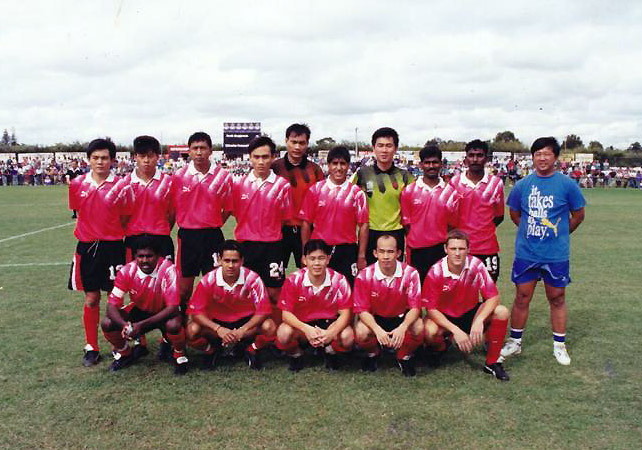
(Gibraltar Crescent, Toh Choon Ming in the front row, third from the left/Photo: Courtesy of Toh Choon Ming)
The talented forward had spent the last 10 years at the semi-pro level in the FAS Premier League where he impressed largely with Gibraltar Crescent and subsequently SAFSA. As Gibraltar merged with Sembawang Sports Club to form Sembawang Rangers under the famed businessman-turned-coach Yow Tian Bey, he had to make the decision whether to turn pro.
It was not easy for Choon Ming to give up his promising corporate career where he was an executive with ROHM for the past three years. Furthermore, the company was already ready to make a leeway for him to start work at 10am and leave at 4pm for his football commitments.
However, he decided to take the leap of faith to pursue his childhood dream on a full-time basis courtesy of the encouragement from his then-girlfriend (now wife).
“She was very supportive back then… Actually I was in a huge dilemma whether to take up this (full-time) offer (from Sembawang),” he told JPF. “But she knew I have this dream since young, so she told me just go for it and try, so that I have no regrets thereafter.”
It looked like the perfect step for Choon Ming who was entering the prime years of his career and he duly struck nine goals to finish as the Stallions’ top scorer with nine goals in his debut season.
However, over time, he grew tired of people questioning whether he is worth what he is paid for as a professional football player and became sick of the game.
“I was being asked why I wanted to become a pro – for me it was passion and not the money,” he explained. “But having purely passion is not the right attitude (as a pro footballer) and I was not enjoying myself. You need some other elements and maybe I lack that.
“Also I felt at that time, we don’t really have the proper infrastructure in place to take care of players, looking after their diets etc. That’s why I stopped.”
Choosing the part-time route
Thus after two seasons with Sembawang, Choon Ming quit earning a living from the game and switched status to become a part-time player in 1998 – linking up with Gombak United whom were making their debut in the S.League that year.
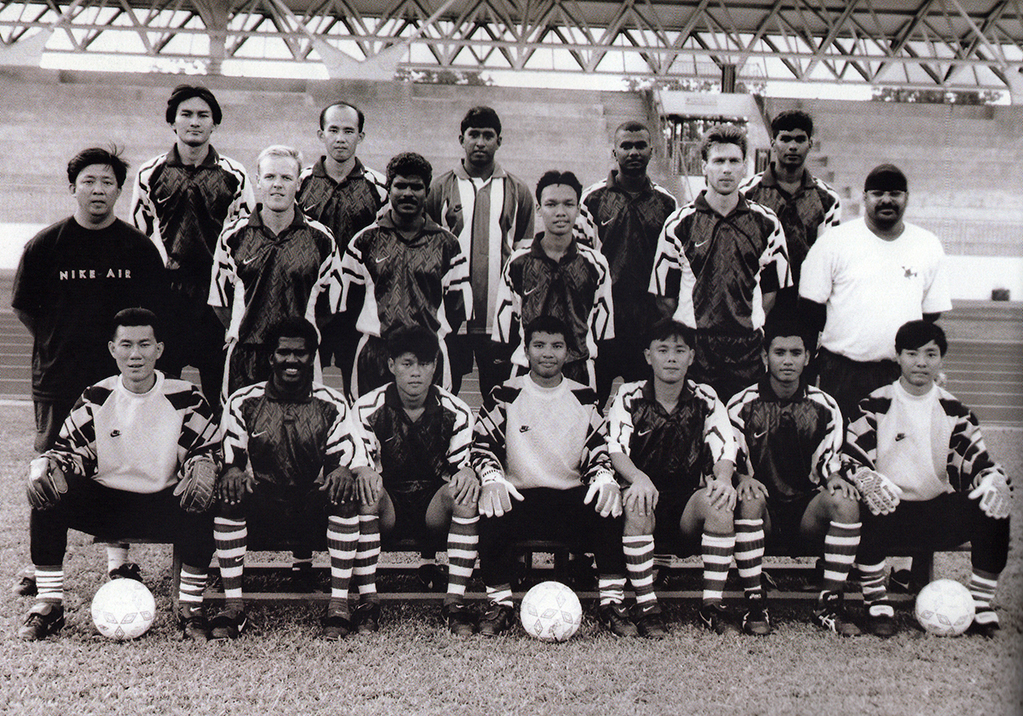
(Sembawang Rangers, Toh Choon Ming in the front row, third from the right/Photo: S.League Kick-Off, JPF collection)
He rejoined ROHM where he had an 8am to 5pm work schedule before reporting for football training at 7pm on a daily basis. It was ‘very tiring’, but that was the path that sounded most logical for him at that phase of his life.
While he had the passion for the game, he knew footballers had a limited life span and did not want to lose precious years to build up his credentials in the corporate world.
In his first season with the Bulls, Choon Ming’s decision to join the rat race gave him some problems as he was unable to turn up on time for training on a few occasions. As such Danish coach Jens Steffensen resorted to dropping him for certain matches and making him train with the reserves. Nonetheless that did not stop him from scoring 11 goals that year.
The following season, David O’Connor took over the Gombak coaching seat and it was under his charge that Choon Ming truly flourished as a player. The Australian tactician knew of his commitments outside football and gave him special exceptions to succeed.
“He was very open with me from the start. He has a bunch of full-timers, but not all of them can be always inside his first 11 for every match,” he shared.
“That’s why he gave the part-timers – there was a few of us – privileges like ‘do your best and the next few days you no need to come for training’. He was okay for me to turn up 10 to 15 minutes late for training if I’m caught up at work, provided that I inform him early.”
Year 1999 – a year of extreme highs and lows
He started season 1999 off on the best possible note, netting a classy brace – a well-placed header and a cheeky chip – to help Gombak come from behind to defeat the much-more fancied Geylang United (now known as Geylang International) 2-1 in front of 2,500 fans at Bukit Gombak Stadium.
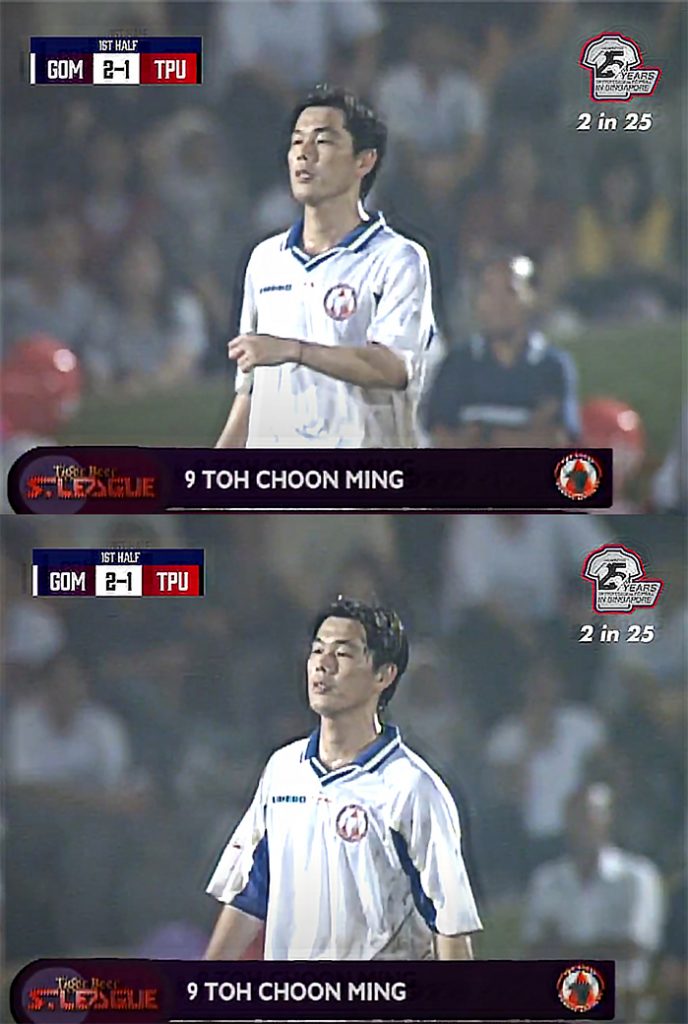
(Photos: Screenshots/FAS, S.League YouTube)
It was said that the odds had the Eagles to win by at least two goals at that time and that duly earned him the plaudits in a local newspaper with the title ‘part-timer outshines the top pros’.
Without the need to justify his salary coupled with the new flexible arrangement by O’Connor, it provided all the right elements for Choon Ming to thrive as he found joy in the Beautiful Game once again. For him, it was like a hobby to relax away from his day job and he described that period as one in which ‘everything I do, the ball just keep going in’.
Another factor key to his free-scoring ways was that he got deployed in his favoured role – which is being a traditional out-and-out no. 9.
“Of course every coach got their own tactics. At Sembawang, I was expected to do more than just being a no. 9 – they want me to run around to create space for others to score as well,” he elaborated.
“At Gombak, the plan was very clear – David just want me to get into the box and focus on finishing off the chances. It helped that I have very good midfielders – there was Ballamodou Conde, J Surachai and Jorgen Nielsen – which makes it so easy for me to score.”
Choon Ming attributes his knack of scoring goals to a combination of natural talent and hard work. Standing at 1.76m, he was not the tallest of forwards but managed to score a fair share of headers.
“My biggest strength was heading. My dad was a basketball player who played at the constituency level and he taught me the technique on how to jump since young, so I could really jump,” revealed Choon Ming, whose childhood idol was legendary Dutch forward Marco van Basten.
“I don’t think I was a super talented player, but I trained very hard at that time to perfect my heading as well as the control with my feet. Another thing is that I have very good instincts (in the box). I remember Surachai met my kids (many years after retirement) and told them ‘your dad is the laziest player I’ve ever seen but he cannot stop scoring goals!’ “
Choon Ming was undoubtedly at the peak of his game that year and that raised hopes of him finally representing the Singapore national team at a major tournament proper at the age of 29.
His international career is a story of missed opportunities over the years, after he was first called up by the late Milouš Kvaček in early 1992.
Coming on a sub in a 2-1 loss against Indonesia in the AFC Asian Cup qualifiers, the then 22-year-old was keen to make an impression amongst a star-studded Lions team alongside the likes of Malek Awab, Razali Saad and Hasnim Haron that participated in the FAS semi-pro league and Malaysia Cup campaign.
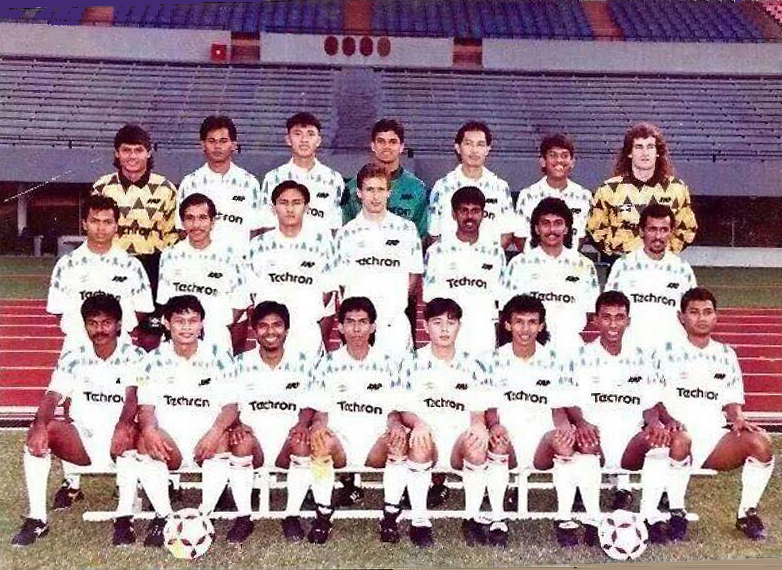
(Singapore National Team, Toh Choon Ming in the front row, fourth from the right/Photo: Courtesy of Toh Choon Ming)
However, Kvaček left after just two months due to disagreements with the Singapore FA and he rarely got any playing time under his replacement P.N. Sivaji.
His next big chance came five years later in 1997 when he was named in that year’s Southeast Asian (SEA) Games squad. That was when he had just returned to the corporate world and was unable to take leave in his probation period.
He was also called up for the Tiger Cup qualifiers and cup finals in 1998, but had to withdraw on both occasions due to work commitments.
Year 1999 gave Choon Ming fresh hope for a new start with the national team as he was recalled into the Lions’ den early that year by coach Vincent Subramaniam – making his first appearance for the country in seven years by coming on a substitute in a friendly against Brunei.
He was then involved in the bulk of the preparations for the 1999 SEA Games where he impressed in a friendly against China’s pre-Olympic team with his ability to hold up the ball and bring others into play. Vincent had earmarked him as a replacement for the retired Fandi Ahmad to lead the Lions’ attack in that tournament, where he could guide the rising talents of Ahmad Latiff and Indra Sahdan.
However, fate would have it that he suffered a heel injury in the lead-up which ruled him out of the tournament which kicked off in late July that year. The Lions duly ended the tournament in the semis after a 2-0 loss to Thailand, which left him wondering what it could have been.
It was a tough period for Choon Ming, who had to cope with the speculation that he was a selfish player who cared for himself and is reluctant to be involved with the national team.
He never got a shoo-in at the international stage again and admitted it was his biggest regret that he never proved his abilities with the Lions.
“It was sad to hear those things, but I cannot do anything about what people want to say,” he said. “Honestly if I had my way, I would love to play more for the country. Everyone should feel proud wearing the national jersey and the same goes for me.”
Nonetheless, he did not allow that disappointment to get to his head as he ended the year on a high – celebrating the birth of his first child after three years of marriage and finishing as top local scorer with 17 goals (just six behind Golden Boot winner Mirko Grabovac from SAFFC).
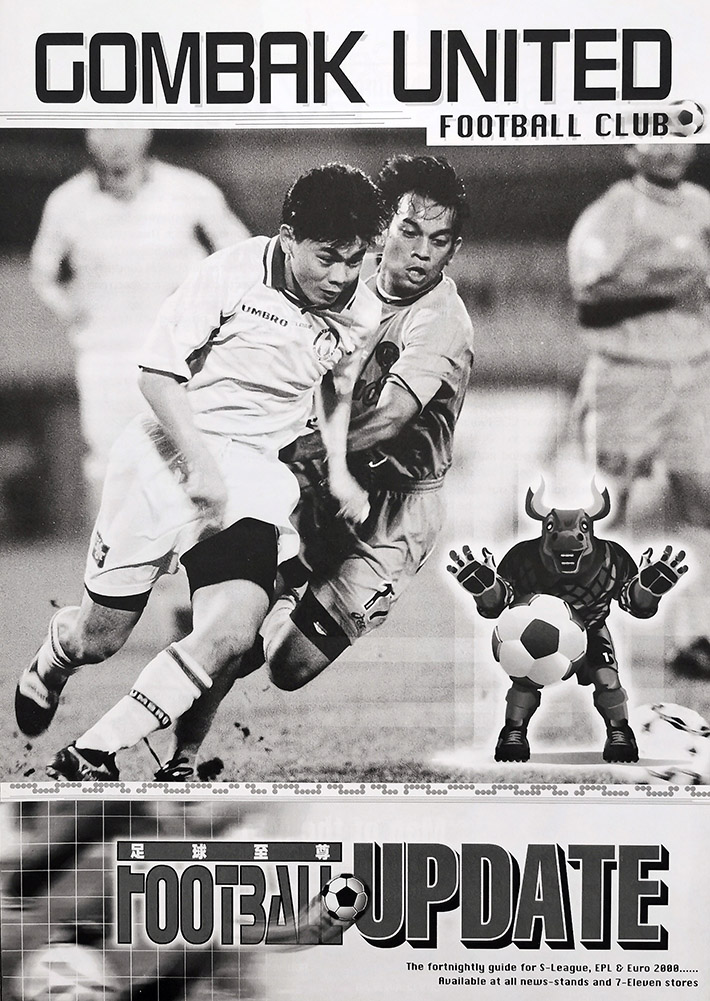
(Photo: Courtesy of Toh Choon Ming)
He recalled the most memorable match of his career, which was scoring a hat-trick in a Singapore Cup clash against eventual winners SAFFC to help the Bulls to come from behind twice in a 3-3 draw.
“I remember this game because one spectator threw a (Singapore Pools) betting slip at me when I was walking into the tunnel after the game,” he reminisced.
“I picked it up and realised he would have won a few thousand dollars if I had not scored the equaliser. That was actually a ‘shiok’ feeling!”
Staying at Gombak despite various offers
Going into the following season in 2000, his stock was at an all-time high. It was mentioned in the papers that he was wanted by as many as nine clubs and there was one who even offered him three months’ salary in advance.
However, his love for the club meant he followed his heart to re-sign for Gombak for a third straight campaign. It was the same club, but things were beginning to change at the Bulls with Malaysian coach Moey Yoke Ham replacing O’Connor after the latter had a fall-out with chairman John Yap while the club was involved in an unsavoury lawsuit with their main sponsor.
The Bulls did well to equal the previous season’s fifth-place finish, but Choon Ming’s output dropped significantly as he was unable to adapt to Moey’s tactical plans which involved the striker to do more off-the-ball work as compared to staying in the box to score.
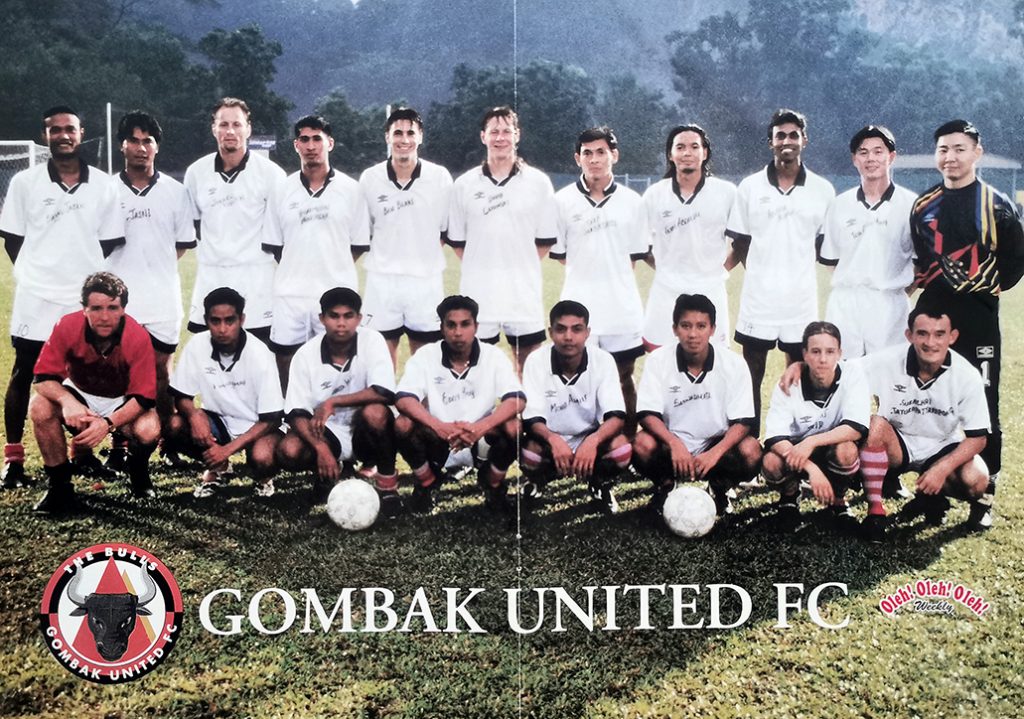
(Gombak United, Toh Choon Ming standing second from the right/Photo: Courtesy of Toh Choon Ming)
His goalscoring exploits the previous year also meant he was often singled out by the opposition as the man to stop and he was at the receiving end of some tough treatment.
“The most ridiculous one was playing against SAFFC. They deployed a player to follow me all the way throughout the match,” he revealed. “At one stage when I went out of the field, he was also standing beside me! That was really annoying.
“And often when you play against the foreigners, they will usually try to trash-talk and say things like ‘I’ll break your leg’ to intimidate you.”
Choon Ming was contemplating to retire at the end of that year due to a persistent back problem. However, an opportunity to link up with the legendary V Sundramoorthy – who was then player-coach of Jurong FC – for the following 2001 season proved too hard to resist.
Deployed in his favoured fox-in-the-box role again, he enjoyed a good campaign with the Cobras and was the club’s second-highest top scorer with 14 goals.
“It was an enjoyable time – just like Gombak, I had very good midfielders helping me out. There was Park Tae-Won and Itimi Dickson on the wings, there was (Goh) Tat Chuan in the middle and Sundram will often come on in the second half to play just behind me,” he recalled.
However, Choon Ming would be lured back to Gombak by Chairman John Yap for the following season in 2002, but it was never the same love affair again with the Bulls. In addition to the ever-lasting problems with his back, the club was experiencing crippling financial issues and oversaw a change of coach as many as four times throughout the season.
Eventually he only recorded four goals as the club finished last and pulled out of the S.League at the end of a turbulent campaign. He would then make the decision to call time on his football career at just 32 years old and focus on his path in the corporate world.
The post-football life
He initially started a joint business venture with a polytechnic friend after retirement, but the irregular working hours compromised on his family time and he would make the decision to return to ROHM two years later – where he is still working at as of today.
Unlike most football players, he never thought of becoming a coach or being involved in the backend of things in the sport. What is more surprising is that he is not even invested in watching the sport on television.
“After you have kids, your focus is all on them so I rarely have time to watch football. My girl is now 21 years old and my boy is 16. I only watch the EPL (English Premier League) sometimes because my daughter follows it,” he shared. “I also don’t play much recreationally. I have a social football team that was started a few years ago, but I rarely join them to play.”
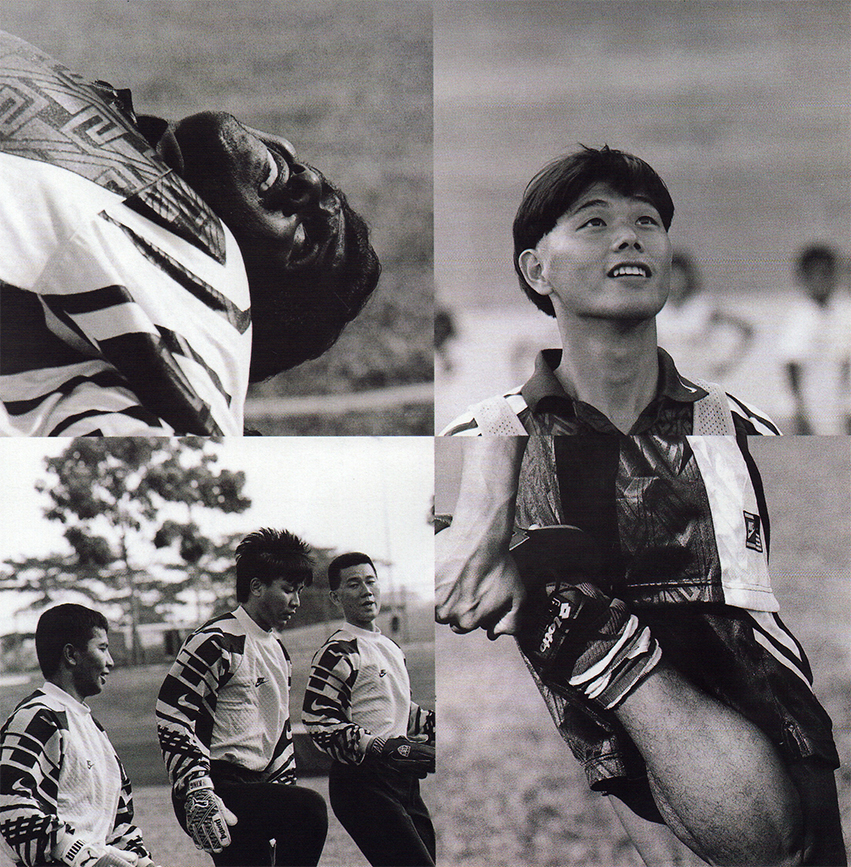
(Photo: S.League Kick-Off, JPF collection)
Now 51 years old, Choon Ming is almost unrecognisable from his playing days where he was famed for his flowing locks. He currently sports a neat crew cut and is happy to live the quiet life away from football.
“Yes, no one recognises me now when I walk on the streets. I’m not as famous as the other Chinese players like (Lim) Tong Hai, (Lee) Man Hon or Steven (Tan)!” he chuckled. “I only keep in touch with a few people from my playing days like (former Gombak teammate) Stephen (Ng) and Quek Hock Tiong.”
Nonetheless he looks back on his football career with pride – one in which he showed it is possible to excel despite being a part-time player. His father had kept all the newspaper coverage of him in his heydays – which he now keeps in a small drawer in his home.
“I’ve very thankful that my dad kept all these newspaper reports. He watches my every game back then. Whenever I play well or score, he will buy the papers the next day, cut it out and laminate – be it from Zaobao, Wanbao or Straits Times,” he disclosed.
“I feel really proud of what I’ve done in my football career, especially to shine amongst an era where there are prolific foreign forwards like Mirko and Egmar (Goncalves).”
Where’s the next Chinese no. 9?
And it is safe to say the country has never seen someone like him – the traditional out-and-out Chinese forward – in the past two decades since he retired.
JPF had to ask the million-dollar question – why is there a dearth of Chinese no. 9s (or generally Chinese players) till now? Choon Ming understandably struggled to answer, instead providing a myriad of reasons.
“Firstly I think it depends on individuals. For me, I always think it’s more fun to be in the box,” he explained. “For a goalkeeper for instance, you can save 10 and let in one and still be a villain. For a striker, you can do nothing for the whole game but score the winning goal and be a hero.
“It could be due to physique? Generally Chinese players tend to be smaller in size. But of course the biggest factor is the parents’ mindset and that is indeed not easy to change. During my time, there was a lot of good Chinese players at school level but they never pursued a professional career because their parents don’t allow them to – I think this is an issue that still exists today.
“The life of a football player is very short thus players will always consider to do something else to earn good money if there is a better choice. Hopefully things are improving now – as long as there is a proper pathway and infrastructure put in place, I think more parents will be convinced to allow their kids to pursue football.”
Fact File
Name: Toh Choon Ming
Born: Feb 8, 1970 (age 51)
Professional Career: Sembawang Rangers (1996-1997), Gombak United (1998-2000, 2002), Jurong FC (2001)









8 thoughts on “Catching up with Toh Choon Ming: the prolific part-time Chinese forward who stole the show amongst seasoned pros”
Comments are closed.